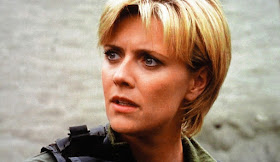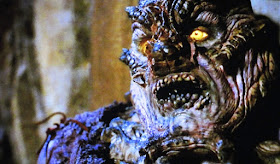"The First One is dead."
-Teal'c believing the First One may in fact be the last one
(that's meant to be funny, come on this is Stargate SG-1)-
(that's meant to be funny, come on this is Stargate SG-1)-



You would be hard-pressed to find a sci-fi concept that has grabbed a foothold or stranglehold in science fiction outside of Star Trek in the same manner in which Stargate SG-1 (1997-2007) managed. Yes, Stargate has essentially, quietly, outsmarted the competition and as such placed a solid second in the running (as North American properties go). It managed to out-star Star Trek and establish its own lasting legacy, mythology and thriving franchise. Despite the failure of Stargate Universe (SGU), like Star Trek, it too will one day return. Stargate may be what the MAC is to PC. That's no easy feat. Major credit goes to the creators behind this series taking a concept and idea born of Dean Devlin and Roland Emmerich's original 1994 film and turning it into so much more. There were moments this writer thought the Stargate franchise might never go on hiatus but alas things fell silent following SGU (2009-2011). For now.


Writer David Gerrold once annotated a host of franchise similarities in an article titled Stargate: Trek in the book Stepping Through The Stargate: Science, Archaeology And The Military.
Both shows have: a homebase, a hero that's macho but understands limitations, brilliant but hot babes with great cheekbones, a disregard for authority (at times), a core that works like family, freedom from court-martialing, homogeneous alien planets, human aliens, tame aliens, English-speaking aliens with stilted language and the adventure of the week concept. Gerrold spends much more detail on these things and the article, like the book, is a worthy investment.

Where the two shows decidedly differ is in humor, according to Gerrold, or a lack thereof when it comes to Star Trek. Also, Star Trek has fabulous technology. Stargate SG-1 not so much. In fact, the series primary directive seems to be seek out fabulous technology to make Stargate SG-1 more fabulous. As a result SG-1 does discover its fair share of nifty stuff.
But yes, Stargate SG-1 and its creative team really tapped into something. Perhaps it benefits structurally from some of the formula that worked so well for Star Trek, while making its core science fiction directives unique in their own right. You would hardly make the association. Who knew?

How many franchises, or science fiction arrivals boast the kind of competitive strength and power of the Star Trek franchise? Right. Only Stargate comes close and continues to offer the greatest potential for storytelling.
Both have wonderful mechanisms for discovery, the Enterprise and the Stargate, allowing for an endless bounty of possibilities.
Stargate SG-1, Season One, Episode 8, Thor's Hammer is your standard early era adventuring out of the stargate with the SG-1 team complete with sometimes overly melodramatic acting and dialogue, but things are getting there.


Most impressive about Thor's Hammer is the effort by its writers to push the mythology of the series. Utilizing Norse mythology, the Vikings and, of course, the Asgard, Stargate SG-1 pushes to introduce new allies and new aliens to its universe.
We may not see the Asgard for awhile, but this is where their story begins. It would continue with Stargate SG-1, S2, Ep6, Thor's Chariot and so on. The Asgard would also, of course, look less like Vikings and more like extras from Dark Skies (1996-1997) or The X-Files (1993-2002) proving this advanced, intelligent race had clearly perfected the art of public relations via image, appearance and presentation in what amounts essentially to extraterrestrial politics 101.

Marvel's Thor has no competition from the Thor represented here either. But speaking of comic book characters, SG-1 fictional Thor hologram comes off slightly cartoonish like a visit to a Disney World ride of course it's an illusion by The Asgard and they have done their very best here.
The story begins on Cimmeria, the name of Conan The Barbarian's homeland as penned by Texan Robert E. Howard. The minions of the sword and sorcery world appear to come to life through the appearance of the primitive peoples encountered on Cimmeria by the SG-1 team.
In Thor's Hammer, fittingly like that legendary weapon, the Asgard is introduced as a potential ally to the human race and equally an enemy to the conquering Goa'uld.

Also notable in fleshing out and exploring this franchise universe is the introduction of Unas, also referred to as the First Ones. Unas (the name of an Egyptian king 2323 BC) were alleged to be the first species to be utilized as a host by the Goa'uld even before the Jaffa. The large creature here, voiced by Darth Vader's James Earl Jones but performed by Vincent Hammond (do you think he knew Jones would be doing the voice?), seemed physically more impressive and imposing than those that would inhabit the later Stargate SG-1, S4, Ep8, The First Ones episode. Nevertheless, it stands to reason, like humans, these creatures would vary in shapes and size.
The Unas were believed to be a myth by the Jaffa, slaves of the Goa'uld, through childhood stories and even Teal'c's surprised reaction upon meeting the creature demonstrates this profound realization of its existence.

The prosthetic, costume design and creature effects' work are top notch particularly when so many science fiction series resort to the generally lazy use of CGI. Stargate Universe has also deferred to the use of CGI though to generally good effect. These are the kinds of creature effects that infuse a science fiction with a sense of realism and weight. Guillermo del Toro's creature work comes to mind in such instances.
The parasitic race that is the Goa'uld is discussed including Teal'c's own challenges with the Goa'uld symbiot within him. Symbiot's inevitably establish themselves as a humanoid's immune system. The same holds true for Teal'c.

One of the least impressive components of Thor's Hammer is the melodramatic exposition. The back story and details surrounding character Kendra are positively yawn worthy. It's just not good. Not to mention Daniel Jackson and Samantha Carter appear almost too gullible in their willingness to go along with everything they seem to know little about. Jackson comes off like a weenie pining away for Sha're, waxing poetic on theory and going along with Kendra's belief in the wind and other ramblings. As a result the two operate completely on feeling and hunches. This is unacceptable for Earth's military warriors at least in the case of Carter.

Other notable oddities include why on Cimmeria the SG-1 team would randomly come tumbling through the stargate. Huh? Someone thought that would be amusing. The humor on Stargate SG-1 works most of the time.
Also, in a rare instance, Stargate SG-1 seems to quickly violate established rules within the mythology. Kendra's Goa'uld is removed and she survives, but Teal'c cannot?
So Thor's Hammer is an Asgard device for extricating the Goa'uld parasite and freeing the host. It sits for all arrivals at the stargate. In the end a decision is made to destroy the device so that Teal'c may walk free of the labyrinthine prison-like maze as extrication of the symbiot might kill him. Daniel's romantic hopes and dreams for Sha're are dashed and the overly dramatic overtures ring just a little too much in Thor's Hammer.


What exactly the Unas was doing in the maze is another story. Perhaps it decided to live and dine there with no way out itself.
The episode is not without its virtues as there is moral subtlety. Jack O'Neill makes a stand for his friend. O'Neill hands Jackson Tealc's staff to demonstrate his loyalty to the team, especially as a newly acquired civilian outsider. Jackson is forced to make a difficult decision that ultimately impacts his lost love. A demonstration of loyalty and family is established here early in the series. The move toward this dynamic is presented quite firmly within the generally entertaining Thor's Hammer.

The lovely melodies of Joel Goldsmith are indeed a delight to the ear, and likely ramp up and elevate the drama even more since Goldsmith was that good.
Nor do I miss Teal'c's character affects and facial gestures which play to the extreme in the early going. Either Christopher Judge improves in the role, which he does, or this writer somehow softened to the sometimes cartoonish displays. Perhaps it's a bit of both.

Thor's Hammer is a generally straightforward exploration piece for the upstart series and one that isn't particularly interesting visually but still entertains. It leaves loads of room for improvement for the series and the series takes that and does indeed build upon it markedly.
In the end Daniel Jackson bids farewell and expresses an interest in friendship with the Asgard. They also bid Kendra a fond goodbye and good riddance.
Writer: Katharyn Powers. Director: Brad Turner.
I know, not feeling it right?
And of course The World According To Jack O'Neill selection of the episode which also includes a good bit of Stargate mythology.
































No comments:
Post a Comment